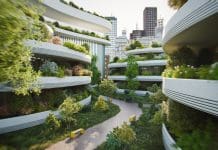Andy Rutter, owner of Steel and Glass Balustrades shares his thoughts on the popularity of glass buildings…
Iconic glass buildings are a highlight of London: The Shard, Leadenhall Building and St Mary’s Axe are all buildings we associate with the capital and have tourists flocking to take photographs of. With new development plans in place, there seems to be no stopping these glass buildings appearing in London, and the rest of the world.
Why Glass?
London is filled with beautiful, historical buildings, such as Westminster and St Pauls Cathedral. Whilst the city has so much history, it is also the buzzing capital of the United Kingdom. As the economic centre point, glass buildings contrast with the old buildings. Architects and designers strive for new ideas and creative thinking through new, iconic glass buildings.
Since the birth and development of skyscrapers, glass has been used to maximise natural light and is highly weather resistant. Using steel structures means that glass can now be used for these buildings.
However, it’s not all about the look. New initiatives are put in place for buildings to control light and heat, which is an important factor to consider in a society which is taking strides towards sustainability. For a building such as The Shard, developments were made to adapt to light levels and help maintain heat and light within the building.
Global success
The use of natural light in designing buildings has been taken advantage of in recent years, and we haven’t just seen it in London. Japan, Spain and many other countries have developed some stunning glass architecture. Glass for Europe, the trade association for Europe’s manufacturers of building, automotive and transport glass, claim that this is just the beginning for buildings using glass, as the development also brings with it modern design principles.
Future developments
One Blackfriars is the latest large-scale architectural project to be started in London, offering stunning views across the city through a glass building. New designs using glass are being thought of constantly, such as the suspended glass swimming pool (part of the Embassy Gardens development at Nine Elms in south-west London), which allows you to swim while you enjoy a view of the Houses of Parliament and the people below in London. These buildings aren’t just popular with architects either. People see modern glass buildings as an iconic part of the city they live in. Residents of St Albans staunchly voted against one of their favourite glass buildings being turned into brick and changed into flats.
Are we going to see more buildings like this in the future? The answer is yes. The Crystal Palace was one of the first of its kind in London. Since then, glass has given designers and architects new ways to be creative, making practical buildings for the work and home, plus drawing tourism as people come to see these spectacular buildings. ■
. . . . . . . . . . . . . . . . . . . . . . . . . . . . . . . . . . . . . . . . . . . . . . .
Andy Rutter
Owner
Steel and Glass Balustrades
Tel: 01244 535477
andy@steelandglassbalustrades.co.uk
www.steelandglassbalustrades.co.uk













